Painted in isolation on the walls of his final home, and never intended for public viewing, Goya?s series of late, dark pictures have become icons. In Halloween week, MutualArt gets a bit too close to the works known as The Black Paintings.
 Francisco de Goya, Saturn (1819?1823)
Francisco de Goya, Saturn (1819?1823)
In February 1819, Francisco de Goya, whose own ears were already rushing with the deafness brought on by lead poisoning, signed the deed of purchase for an isolated estate known as The Deaf Man?s House. It was named for the previous tenant, but the nominative determinism is a telling detail of the great painter?s later years. Onto the walls of his final home, Goya would paint a series of tenebrous and horrifying works which he never intended anyone to see. They came to be known as The Black Paintings.
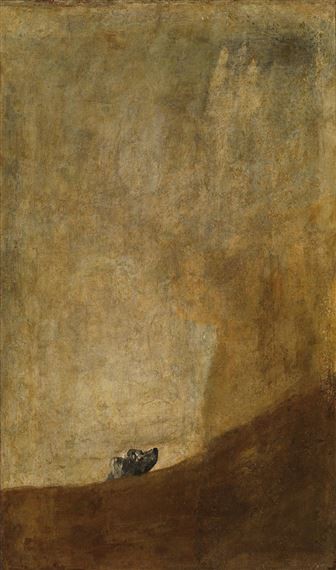 Francisco de Goya, Dog (1819?1823)
Francisco de Goya, Dog (1819?1823)
Goya had, thus far, led a social life, full of conversation and song. His reputation as a genius painter rested on his searching, intimate portraits. He habitually sought and loved the company of people from all social backgrounds ? as Juan Jos Junquera notes, when the painter moved from rural Aragon to Madrid in 1774, ?working people of all kinds, from muleteers, builders, tradesmen, dandies and dirty old men to young people, began to refine his brushstrokes, sharpen his vision, brighten his colours and prepare him for what was to become the basis of his career as a painter ? the portrait.? He was a painter of people. He was a man of the people. He was, in the modern sense, ?a people person.?
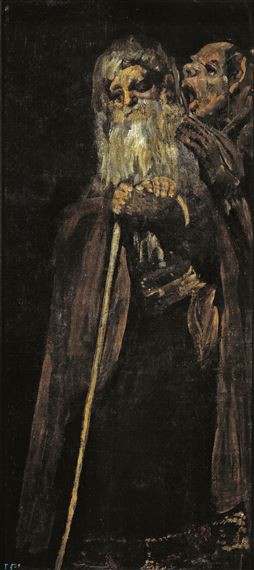 Francisco de Goya, Two Old Men (1819?1823)
Francisco de Goya, Two Old Men (1819?1823)
Social, political, and physical transformations in Goya?s life changed the ebullient youth of Madrid into the reclusive man who painted some of art history?s most disturbed and disturbing pictures.
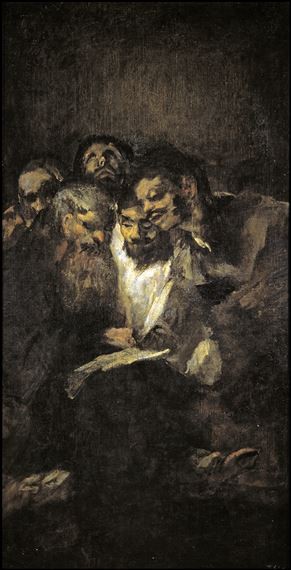 Francisco de Goya, Men Reading (1819?1823)
Francisco de Goya, Men Reading (1819?1823)
Luscious oils and the spring of canvas gave a taut sense of social humanity to his best portraits. Their light imbued flesh with a living quality, their faith to reality gave a sense of honesty ? an honesty only redoubled by the liberties he took to make the eyes supernaturally expressive, the fasciae exaggeratedly communicative. His Portrait of Maria Luisa de Parma (1789) is a perfect example of these qualities, whilst also showcasing the keenness of observation and detail which allowed him to both celebrate and complicate the lavishness of Madrid?s upper classes.
 Francisco de Goya, Two Old Men Eating Soup (1819?1823)
Francisco de Goya, Two Old Men Eating Soup (1819?1823)
If it seems a very long way from such sumptuous, social painting to the unforgiving bleakness of the picture known as The Dog (1819?1823), or the unrelenting horror of his picture of Saturn, it might be worth thinking again about what might motivate such a man as Goya to imagine and enact such things as The Black Paintings. Perhaps, because we fear the loss of the things we love, and because that loss is absolutely assured in death, the Black Paintings exist within and behind those images and objects we cherish as materially ?good.? If we think again, perhaps Goya was always destined to bring such images into the world. And, because we may as well do so without flinching, that terrible image of Saturn is as good a place to start thinking again.
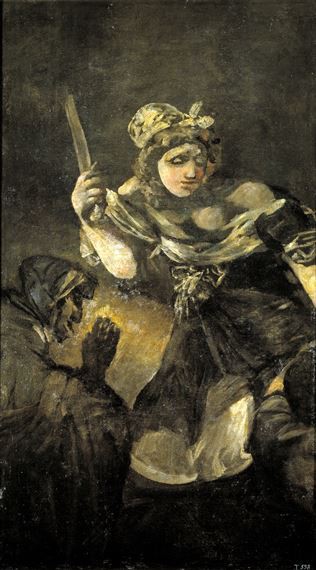 Francisco de Goya, Judith and Holofernes (1819?1823)
Francisco de Goya, Judith and Holofernes (1819?1823)
Some consider Peter Paul Rubens? Saturn Devouring His Son (1636) to be the definitive depiction of this scene from Greek mythology, in which the Titan Cronus (?Saturn? in the Roman myth) eats each of his children upon birth, because a prophecy foresaw that his child would overthrow him. Rubens? picture is more ?realistic,? perhaps increasing its sense of horror, with Saturn himself depicted as a cold-hearted old crony, on the scale of an ordinary human, systematically erasing threat, untroubled by his actions. The triple-star in Rubens? painting is the planet Saturn and its rings, which 17th century astrologers mistook for two stars rising alongside.
 Francisco de Goya, The Witches? Sabbath (1819?1823)
Francisco de Goya, The Witches? Sabbath (1819?1823)
Instead of depicting Saturn as human, the tormented Goya plumbs the depths of the imagination and brings back a twisted Titan, an image so monstrous that it has become ingrained in the minds of viewers for hundreds of years. The gore and the grotesquery are unbridled. It is almost universally considered the scariest painting of all time. But if it were simply a conjuring of the imagination, it would perhaps be less affecting. To some extent, its potency relies on the fact that all works of disturbing art function as evidence of an extremely troubled human mind. What must the artist have suffered, we ask ourselves, to come up with such a twisted picture?
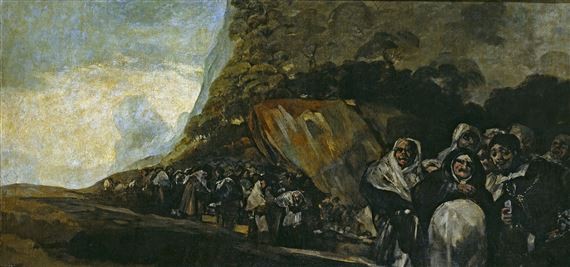 Francisco de Goya, Procession of the Holy Office (1819?1823)
Francisco de Goya, Procession of the Holy Office (1819?1823)
But, the present discussion argues, Goya?s picture is particularly scary precisely because we can see it foreshadowed in his earlier work. We?ve said that the light in Goya?s portraits gave a living, fulsome quality to the sitter?s flesh. Yet, as John Berger notes, ?Goya lived and observed through something near enough to total war to know that night is security and that it is the dawn that one fears. The light in his work is merciless for the simple reason that it shows up cruelty.?
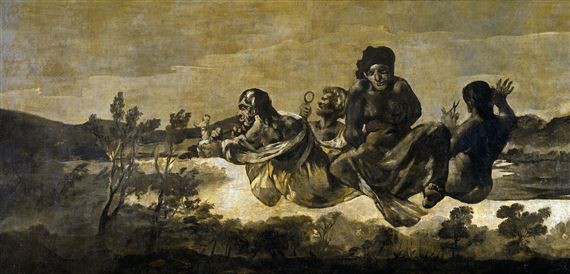 Francisco de Goya, The Fates (1819?1823)
Francisco de Goya, The Fates (1819?1823)
The light points the way for the enemy. Light is frailty and ephemerality. On that taut and nubile canvas, the lit flesh looks good enough to eat. Berger again: ?The flesh has an expression of its own ? as features do in portraits by other painters. The expression varies according to the sitter, but it is always a variation on the same demand: the demand for flesh as food for an appetite. Nor is that a rhetorical metaphor. It is almost literally true. Sometimes the flesh has a bloom on it like fruit. Sometimes it is flushed and hungry-looking, ready to devour. Usually ? and this is the fulcrum of his intense psychological insight ? it suggests both simultaneously: the devourer and the to-be-devoured.?
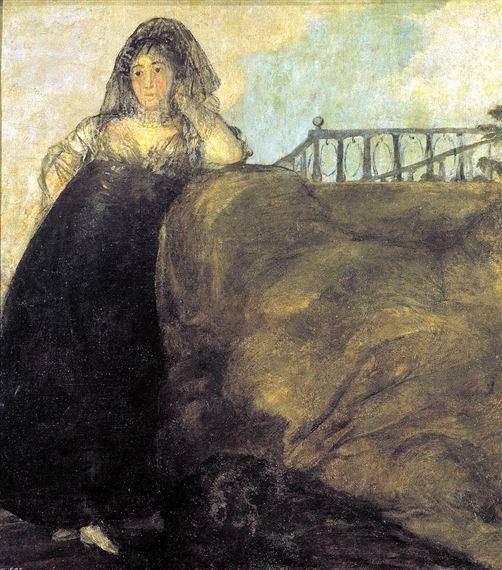 Francisco de Goya, Leocadia (1819?1823)
Francisco de Goya, Leocadia (1819?1823)
And so, in the act of devouring, the nubile fleshy spring of the canvas is pierced by the devourer. It gives way to the matte, lifeless, form of Saturn?s bleeding son, painted directly onto the stone of The Deaf Man?s house. In his later life, Goya became appalled and terrified by the appetites of the flesh. Hence his depiction of Judith slaying her rapist. Hence the painting of women laughing, perhaps deriding male sexuality.
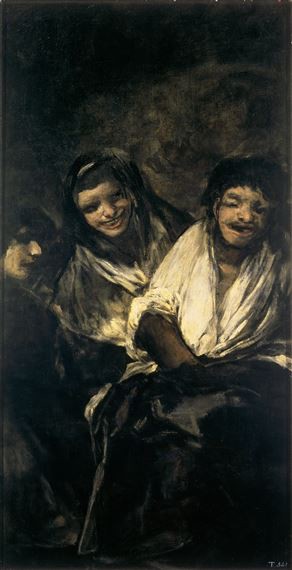 Francisco de Goya, Women Laughing (1819?1823)
Francisco de Goya, Women Laughing (1819?1823)
Goya?s paintings are always defined by action. At one point, this was a social impulse. Later, it is the active opposite. And so the Black Paintings are not just representations of ?lack.? They are the willed purpose of non-being, the archetypal harbingers of the opposite of life. Their yawning spaces are not just empty, they have been emptied. Flesh does not just decay unto death: it is devoured. Time doesn?t pass, is not ?passive?: it is exacting and ritualized. And, in the deaf man?s house, silence is not just the absence of noise: it roars.
For more articles, auctions, exhibitions, and current art trends, visit MutualArt.com

